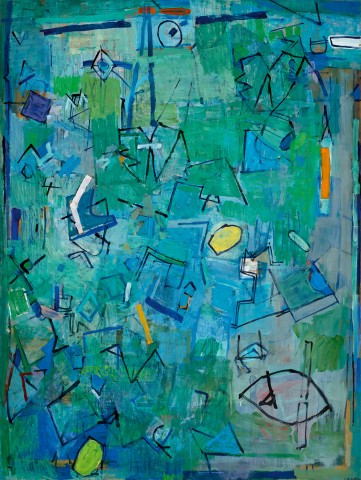LANDSCAPE AT MIDNIGHT, 1966 – 67
YVONNE AUDETTE
oil on plywood
152.5 x 114.0 cm
signed and dated lower right: Y. Audette 66
signed, dated and inscribed with title verso: Y. Audette 1966 – 67 / landscape at midnight /
Private collection, Melbourne
‘The calligraphy – that’s why I like the transparency because you could see underneath it every form, structure, mark that had been put down before – nothing was ever lost. It is like the inside of a human being, everything is there, what you say and do is always there in human experience. I want to do this in my painting; to build up layer, upon layer – put on top. Everything underneath is important.’1
Unlike many Australian artists at the time, Yvonne Audette took the unusual step, when choosing to venture abroad to further her career, of travelling to New York rather than London – a decision which not only reveals the young artist’s independence of mind and willingness to chart her own path, but more profoundly, impacted the entire course of her artistic development. Arriving in New York in late 1952, she accordingly enjoyed first-hand exposure to the burgeoning school of Abstract Expressionism through the work of celebrated exponents including Willem de Kooning, Robert Motherwell and Mark Tobey, before subsequently travelling to Europe, where she established a studio in Florence in 1955, before finally settling in Milan in 1963. Against the backdrop of Italy’s rich culture and artistic past, she was welcomed into a community of professional artists (including Arnaldo Pomodoro and Lucio Fontana) who encouraged her and provided an aspirational example. When she eventually returned to her hometown of Sydney in 1966, not surprisingly Audette cut an unusual figure among her largely male local peers. Well-travelled and well-connected with influential members of the New York Avant Garde, she had matured as a painter and was now working in a subtle and nuanced abstract style derived from the ambiguous mark-making of European Art Informel.
A superb example of her work from the sixties, Landscape at Midnight, 1966 – 67 exudes the confidence of an artist who had reached creative maturity. Although completed upon her return to Sydney, the composition was nevertheless commenced in Italy and thus maintains her European frame of reference through allusion and style, reflecting the multi-layered histories Audette had encountered in Europe: ‘When I went to Europe in the mid-50s… my work responded to the layering of society itself – the remnants of murals on walls, the frescoes, the whole antiquity of the civilisation.’2 Complex, multifaceted abstractions, indeed Audette’s works evolve over time; as Christopher Heathcote notes, ‘each painting… the product of months, sometimes years, spent deliberating over how the next stage should be approached and resolved.’3 In this regard, they betray striking affinities with the work of fellow expatriate, Rome-based American artist Cy Twombly, who shared her fascination with the ‘direct visual poetry’ of random, accumulated graffiti found on walls in ancient Italian streets and encouraged her to loosen up and experiment in the quest to discover her own unique voice. As Audette reflects,
‘It was for me a learning experience – I was excited how images were painted out and worked over, reworked over and over – the courage to destroy in order to get something better, closer to what one wants to express. The ability to manipulate paint and seeing the energy this way of working produces in the painting. The importance given to gestural, spontaneous brushwork, acting as the very meaning of the work in itself. All this is very important to me and always will be, it is my way of working, the very act of painting being the content.’4
Temporarily departing from her previous Cantata series which had emerged from Audette’s heartfelt love of J.S. Bach’s music, Landscape at Midnight represents an important transition work, inspired rather by Asian art and calligraphy. Significantly, such influence was absorbed both directly through classes with a Zen painting master while living in New York, but also more obliquely, through exposure to the work of artists such as Franz Kline, Pierre Alechinsky and Bradley Walker Tomlin, who were incorporating calligraphic brushwork into their abstractions. In a manner akin to a palimpsest, thus the image here is built up through accretions of colour and form, intuitive lines, shapes and scribbles painted with the brush, alongside shimmering transparent layers applied with a palette knife before being repeatedly scraped back and then applied again over an extended period. Carefully constructed yet seemingly ‘automatic’ in its creation, indeed the work offers a compelling study in space and depth which, enlivened by calligraphic gesture and lyrical colour, elegantly encapsulates Audette’s remarkable legacy as one of the first painters to bring abstract expressionism to Australia.
1. The artist, quoted in Durie Saines, D., The Will to Paint: Three Sydney Women Artists of the 1950s, Joy Ewart, Nancy Borlase, Yvonne Audette, Masters thesis, Power Institute of Fine Art, University of Sydney, 1992, p. 100
2. The artist, quoted in McCulloch-Uehlin, S., ‘Abstraction’s Forgotten Generation’, The Australian, 23 April 1999, p. 9
3. Heathcote, C., ‘Yvonne Audette: The Early Years’ in Heathcote, C., et. al., Yvonne Audette: Paintings and Drawings 1949 – 2003, Macmillan, Melbourne, 2003, p. 33
4. The artist, quoted in Grant, K. ‘Interview’, Yvonne Audette: Different Directions 1954 – 1966, National Gallery of Victoria, Melbourne, 2008, n.p.
VERONICA ANGELATOS
